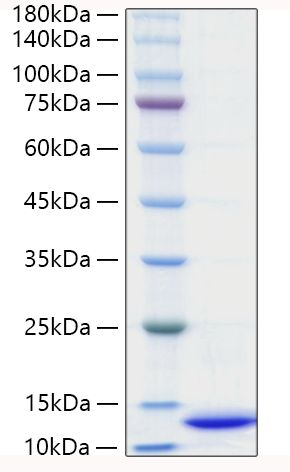Description
Recombinant Mouse CXCL2/MIP-2 Protein
The Recombinant Mouse CXCL2/MIP-2 Protein is a high-quality recombinant protein designed for murine biological research applications. This protein serves as an essential reagent in mouse model studies, comparative immunology research, and preclinical therapeutic evaluations, enabling scientists to investigate CXCL2/MIP-2 biology and its relevance to human disease mechanisms through translational research approaches.
This product (SKU: RPCB1670) is produced using advanced expression systems and features a C-6His tag for convenient detection and purification. The protein exhibits a calculated molecular weight of 8.62 kDa with an observed molecular weight of 10-15 kDa under denaturing conditions, achieving ≥ 95 % as determined by SDS-PAGE., ensuring exceptional quality and consistency for research applications.
Key Features
| High Purity by Affinity Chromatography | |
| Mammalian & Bacterial Expression Systems | |
| High lot-to-lot consistency via strict QC |
| Product Name: | Recombinant Mouse CXCL2/MIP-2 Protein |
| SKU: | RPCB1670 |
| Size: | 10 μg , 20 μg , 50 μg , 100 μg |
| Reactivity: | Mouse |
| Synonyms: | Cxcl2, Mip-2, Mip2, Scyb2, C-X-C motif chemokine 2, Macrophage inflammatory protein 2, MIP2 |
| Tag: | C-6His |
| Calculated MW: | 8.62 kDa |
| Observed MW: | 10-15 kDa |
| Gene ID: | 20310 |
| Protein Description: | High quality, high purity and low endotoxin recombinant Recombinant Mouse CXCL2/MIP-2 Protein (RPCB1670), tested reactivity in Pichia and has been validated in SDS-PAGE.100% guaranteed. |
| Endotoxin: | < 0.1 EU/μg of the protein by LAL method. |
| Purity: | ≥ 95 % as determined by SDS-PAGE. |
| Formulation: | Lyophilized from a 0.22 μm filtered solution of PBS, pH 7.4. |
| Reconstitution: | Centrifuge the vial before opening. Reconstitute to a concentration of 0.1-0.5 mg/mL in sterile distilled water. Avoid vortex or vigorously pipetting the protein. For long term storage, it is recommended to add a carrier protein or stablizer (e.g. 0.1% BSA, 5% HSA, 10% FBS or 5% Trehalose), and aliquot the reconstituted protein solution to minimize free-thaw cycles. |
| Storage: | Store at -20℃.Store the lyophilized protein at -20℃ to -80 ℃ up to 1 year from the date of receipt. After reconstitution, the protein solution is stable at -20℃ for 3 months, at 2-8℃ for up to 1 week. |
Macrophage Inflammatory Protein-2 (MIP-2) was originally identified as a heparin-binding protein secreted from a murine macrophage cell line in response to endotoxin stimulation. Based on its protein and DNA sequences, MIP-2 is a member of the alpha (C-X-C) subfamily of chemokines. MIP-2 cDNA encodes a 100 amino acid residue precursor protein from which the amino-terminal 27 amino acid residues are cleaved to generate the mature MIP-2. The protein sequence of murine MIP-2 shows approximately 63% identity to that of murine KC, another murine alpha chemokine whose expression is induced by PDGF. In addition, the protein sequence of MIP-2 is also 60% identical to human GRO beta and GRO gamma. It has been suggested that mouse KC and MIP-2 are the homologs of the human GROs and rat CINCs. Similarly to other alpha chemokines, murine MIP-2 is a potent neutrophil attractant and activator. MIP-2 and KC can bind the murine interleukin 8 type B receptor homologue with high affinity. The expression of MIP-2 was found to be associated with neutrophil influx in pulmonary inflammation and glomerulonephritis, suggesting that MIP-2 may contribute to the pathogenesis of inflammatory diseases.







